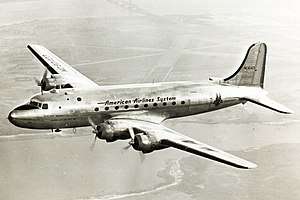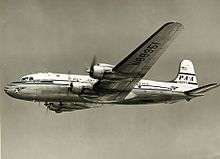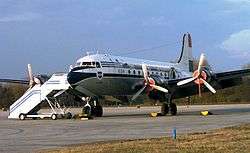Douglas DC-4
The Douglas DC-4 is a four-engine (piston) propeller-driven airliner developed by the Douglas Aircraft Company. Military versions of the plane, the C-54 and R5D, served during World War II, in the Berlin Airlift and into the 1960s. From 1945, many civil airlines operated the DC-4 worldwide.
| DC-4 | |
|---|---|
 | |
| Role | Airliner/transport aircraft |
| National origin | United States |
| Manufacturer | Douglas Aircraft Company |
| First flight | 14 February 1942 (production series)[1] |
| Introduction | 1942 with United Airlines |
| Retired | 1991 |
| Status | In very limited use |
| Primary users | South African Airways Museum Society United Airlines (historical) American Airlines (Historical) Trans World Airlines (Historical) Buffalo Airways |
| Produced | 1942 – August 1947 |
| Number built | 80[2] DC-4 and 1,163 C-54/R5D |
| Variants | C-54 Skymaster Canadair North Star Aviation Traders ATL-98 Carvair |
| Developed into | Douglas DC-6 |
Design and development
Following proving flights by United Airlines of the DC-4E it became obvious that the 52-seat airliner was too large to operate economically and the partner airlines[lower-alpha 1] recommended a long list of changes required to the design. Douglas took the new requirement and produced a new design, the DC-4A, with a simpler unpressurised fuselage, R-2000 Twin Wasp engines and a single fin and rudder. Both designs included tricycle landing gear, unlike the predecessor 2-engine DC-3.
With the entry of the United States into World War II, in December 1941 the War Department took over the provision orders for the airlines and allocated them to the United States Army Air Forces with the designation C-54 Skymaster. The first C-54 flew from Clover Field in Santa Monica, California on 14 February 1942.

To meet military requirements the first production aircraft had four additional auxiliary fuel tanks in the main cabin which reduced the passenger seats to 26. The following batch of aircraft were designated C-54A and were built with a stronger floor, cargo door with a hoist and winch. The first C-54A was delivered in February 1943. With the introduction of the C-54B in March 1944, the outer wings were changed to hold integral fuel tanks allowing two of the cabin tanks to be removed; this allowed 49 seats (or 16 stretchers) to be fitted. The C-54C was a hybrid for Presidential use, it had a C-54A fuselage with four cabin fuel tanks and the C-54B wings with built-in tanks to achieve maximum range.

The most common variant was the C-54D, which entered service in August 1944, a C-54B with more powerful R-2000-11 engines. With the C-54E the last two cabin fuel tanks were moved to the wings which allowed more freight or 44 passenger seats.
A total of 1,163 C-54/R5Ds were built for the United States military between 1942 and January 1946; another 79 DC-4s were built postwar. A variant, equipped to fly over 40% faster, was built in Canada postwar as the Canadair North Star.
Operational history
The DC-4/C-54 proved a popular and reliable type, 1245 being built between May 1942 and August 1947, including 79 postwar DC-4s. Several remain in service as of 2014. One current operator is Buffalo Airways of Yellowknife, Northwest Territories.[3]
Douglas continued to develop the type during the war in preparation for a return to airline use when peace returned. The type's sales prospects were affected when 500 wartime ex military C-54s and R5Ds came onto the civil market, many being converted to DC-4 standard by Douglas. DC-4s were a favorite of charter airlines such as Great Lakes Airlines, North American Airlines, Universal Airlines and Transocean Airlines. In the 1950s Transocean (Oakland, California) was the largest civil C-54/DC-4 operator.


Douglas produced 79 new-build DC-4s between January 1946 and August 9, 1947, the last example being delivered to South African Airways (8). Pressurization was an option, but all civil DC-4s (and C-54s) were built un-pressurized.
A total of 330 DC-4s and C-54s were used in the Berlin Airlift, which made them the most used types.
Purchasers of new-build DC-4s included Pan American Airways, National Airlines, Northwest Airlines and Western Airlines in the US, and KLM Royal Dutch Air Lines, Scandinavian Airlines System, Iberia Airlines of Spain, Swissair, Air France, Sabena Belgian World Airlines, Cubana de Aviación, Avianca, Aerolíneas Argentinas, Aeropostal of Venezuela (1946) and South African Airways overseas.[4] Several airlines used new-build DC-4s to start scheduled transatlantic flights between Latin America and Europe. Among the earliest were Aerolíneas Argentinas (1946), Aeropostal of Venezuela (1946), Iberia Airlines of Spain (1946), and Cubana de Aviación (1948).
Basic prices for a new DC-4 in 1946–47 was around £140,000-£160,000. In 1960 used DC-4s were available for around £80,000.[5]
As of June 2020, there two operational DC-4's in South Africa. Owned by the South African Airways Museum Society, they are operated by SkyClass Aviation for charter operations. Both aircraft (ZS-BMH and ZS-AUB) are in historical South African Airways livery.[6][7]
Variants
- DC-4
- Main production airliner, postwar.
- Canadair North Star
- Canadian production of a Rolls-Royce Merlin powered variant, plus a single example powered with Pratt & Whitney R-2800s.
- Aviation Traders Carvair
- British cargo and car ferry with a modified nose with a raised cockpit to allow cars to be loaded more easily.
Operators
Accidents and incidents
Surviving aircraft

Very few DC-4s remain in service today.[8] The last two passenger DC-4s operating worldwide are based in Johannesburg, South Africa. They fly with old South African Airways (SAA) livery. They are ZS-AUB "Outeniqua" and ZS-BMH "Lebombo" and are owned by the South African Airways Museum Society[9][10] and operated by Skyclass Aviation,[11] a company specialising in classic and VIP charters to exotic destinations in Africa.
A 1944-built DC-4 is currently being restored in New South Wales, Australia.[12] Buffalo Airways in Canada's Northwest Territories owns eleven DC-4s (former C-54s of various versions); four for hauling cargo and three for aerial firefighting.[13] A 1945-built DC-4 (C-54E) c/n 27370 is currently operating as a flying museum of the Berlin Airlift. Called the "Spirit of Freedom", it has been touring the world for nearly 20 years.[14] Alaska Air Fuel[15] also operates two DC4s out of Palmer, Alaska. One ex-Buffalo DC4[16] (N55CW c/n 10673, currently registered to AIRCRAFT GUARANTY CORP TRUSTEE) is fitted with spray bars on top of the wings and is currently based in Florida on standby for oil pollution control.[17]
Specifications (DC-4-1009)

Data from Jane's all the World's Aircraft 1947,[18] McDonnell Douglas aircraft since 1920 : Volume I[19]
General characteristics
- Crew: 4
- Capacity: day transport: 44 pax with baggage and freight; sleeper transport : 22 pax with baggage and freight
- later, up to 86 in high density seating
- Length: 93 ft 10 in (28.60 m)
- Wingspan: 117 ft 6 in (35.81 m)
- Height: 27 ft 6 in (8.38 m)
- Wing area: 1,460 sq ft (136 m2)
- Airfoil: root: NACA 23016; tip: NACA 23012[20]
- Empty weight: 43,300 lb (19,641 kg)
- Gross weight: 63,500 lb (28,803 kg)
- Max takeoff weight: 73,000 lb (33,112 kg)
- Fuel capacity: 2,868 US gal (2,388 imp gal; 10,860 l) normal capacity or 3,592 US gal (2,991 imp gal; 13,600 l) with alternative inner wing tanks
- Powerplant: 4 × Pratt & Whitney R-2000-2SD13-G Twin Wasp 14-cylinder air-cooled radial piston engines, 1,450 hp (1,080 kW) each for take-off
- 1,100 hp (820 kW) at 14,000 ft (4,300 m)
- Propellers: 3-bladed Hamilton-Standard Hydromatic, 13 ft 1 in (3.99 m) diameter constant-speed propellers
Performance
- Maximum speed: 280 mph (450 km/h, 240 kn) at 14,000 ft (4,300 m)
- Cruise speed: 227 mph (365 km/h, 197 kn) 60% power at 10,000 ft (3,000 m)
- Maximum cruise speed 246 mph (214 kn; 396 km/h) in high blower at 20,800 ft (6,300 m)
- Range: 3,300 mi (5,300 km, 2,900 nmi) at 10% above max L/D speed
- Ferry range: 4,250 mi (6,840 km, 3,690 nmi) with inner wing fuel cells
- Wing loading: 50.1 lb/sq ft (245 kg/m2) at maximum gross weight
- Power/mass: 0.0787 hp/lb (0.1294 kW/kg) at maximum gross weight with take-off power
See also
Related development
- Aviation Traders Carvair
- Canadair North Star
- Douglas DC-4E
- Douglas C-54 Skymaster
- Douglas DC-6
- Douglas DC-7
Aircraft of comparable role, configuration and era
Related lists
Notes
- The partners in the project were American Airlines, Eastern, Pan American, Trans World and United
References
- Citations
- "History: Products: DC-4/C-54 Skymaster Transport". Boeing. Retrieved 20 January 2015.
- Piston Engine Airliner Production List 1996
- Stapleton, Rob (15 August 2009). "Brooks Fuel keeps Alaska supplied using legacy aircraft". Alaska Journal of Commerce. Retrieved 27 February 2017.
- Berry 1967, pp. 70–73.
- "de havilland | 1960 | 2687 | Flight Archive". Flight. 18 November 1960. Retrieved 28 February 2017.
- "SkyClassic". SkyClass Aviation. South Africa. Retrieved 7 June 2020.
- "Our Aircraft". South African Airways Museum Society. South Africa. Retrieved 7 June 2020.
- Blewett 2007, p. 101.
- ""Outeniqua" Douglas DC-4 1009 ZS-AUB c/n 42984". South African Airways Museum Society. Retrieved 21 January 2015.
- ""Lebombo" Douglas DC-4 1009 ZS-BMH c/n 43157". South African Airways Museum Society. Retrieved 21 January 2015.
- "Portfolios: SkyClassic". SkyClass Aviation. 31 March 2014. Retrieved 20 January 2015.
- Morgan, Ben. "Engineering Underway on the Douglas DC4". hars.org.au. Archived from the original on 31 January 2012. Retrieved 21 September 2011.
- "Buffalo Airways Aircraft Fleet". Retrieved 17 November 2015.
- "Berlin Airlift Historical Foundation". Retrieved 11 February 2015.
- "City: airport's future bright".
- "Douglas DC-4 "Oil Bomber" Spray Plane at KCGI". seMissourian.com. Retrieved 9 February 2016.
- "N55CW (1942 DOUGLAS C54D-DC owned by AIRCRAFT GUARANTY CORP TRUSTEE) Aircraft Registration ✈ FlightAware".
- Bridgman, Leonard, ed. (1947). Jane's all the World's Aircraft 1947. London: Sampson Low, Marston & Co. p. 219c.
- Francillon, René J. (1988). McDonnell Douglas aircraft since 1920 : Volume I. London: Naval Institute Press. pp. 313–333. ISBN 0870214284.
- Lednicer, David. "The Incomplete Guide to Airfoil Usage". m-selig.ae.illinois.edu. Retrieved 16 April 2019.
- Bibliography
- Berry, Peter et al. The Douglas DC-4. Tonbridge, Kent, UK: Air-Britain (Historians) Ltd, 1967.
- Blewett, R. Survivors. Coulsden, UK: Aviation Classics, 2007. ISBN 978-0-9530413-4-3.
- Francillon, René. McDonnell Douglas Aircraft Since 1920: Volume I. London: Putnam, 1979. ISBN 0-87021-428-4.
- Pearcy, Arthur. Douglas Propliners: DC-1–DC-7. Shrewsbury, UK: Airlife Publishing, 1995. ISBN 1-85310-261-X.
- Yenne, Bill. McDonnell Douglas: A Tale of Two Giants. Greenwich, Connecticut: Bison Books, 1985. ISBN 0-517-44287-6.
External links
| Wikimedia Commons has media related to Douglas DC-4. |
- The last DC-4s flying passenger service
- Vintage Wings of Canada Canadair North Star showing RR Merlin installation
- Life magazine photos by Eliot Elisofon of first production batch of DC-4s being completed (partly outdoors) as military C-54s (note absence of cargo door on these), and including early air-to-air photos of 42-10237 the first DC-4/C-54 to fly